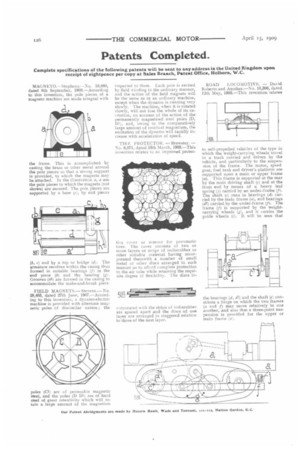Patents Completed_
Page 18

If you've noticed an error in this article please click here to report it so we can fix it.
Complete specifications of the following patents will be sent to any address in the United Kingdom upon receipt of eightpence per copy at Sales Branch, Patent Office, Holborn, W.C.
MAGNETO.—Stephens.—No. 18,88O, dated 8th September, 1908.—According to this invention, the pole pieces of a magneto machine are made integral with the frame. This is accomplished by casting the brass or other metal around the pole pieces so that a strong support is provided, to which the magnets may be attached. In the illustration a, a are the pole pieces to which the magnets (not shown) are secured. The pole pieces are supported by a base (e), by end pieces (b, e) and by a top or bridge (d). The armature revolves within the casing thus formed in suitable hearings (f) in the end piece (b) and the bearing (g;. Grooves (0) are formed in the casing to accommodate the make-and-break piece.
FIELD MAGNETS.— Stevens.— No. 28,483, dated 27th June, 1907.—According to this invention, a dynamo-electric machine is provided with alternate magnetic poles of dissimilar nature ; the
pales (Cl) are of permeable magnetic steel, and the poles (D DI) are of hard steel of great retentivity which will retain a large amount of the magnetism
imparted to them. Each pule is excited by field winding in the ordinary manner, and the action of the field magnets will be the same as in an ordinary machine, except when the dynamo is running very slowly. The machine, when it is rotated slowly, will not lose the whole of its excitation, on account of the action of the permanently magnetised steel poles (D, DI), and, owing to the comparatively large amount of residual magnetism, the excitation of the dynamo will rapidly increase with acceleration of speed.
TIRE PROTECTOR. — Brewster. — No. 6,071, dated 18th March, 1908.—This invention relates to an improved protec
tive cover or armour for pneumatic tires. The cover consists of two or more layers or strips of indiarubber or other suitable material having Incorporated therewith a number of small metal or other discs arranged in such manner as to afford complete protection to the air tube while retaining the requisite degree of flexibility. The discs in
corporate(' with the strips of indiarubber are spaced apart and the discs of one layer are arranged in staggered relation to those of the next layer.
ROAD LOCOMOTIVE. — David Roberts and Another.—No. 10,306, dated 12th May, 1908.—This invention relates to self-propelled vehicles of the type in which the weight-carrying wheels travel in a track carried and driven by the vehicle, and particularly to the suspension of the frame. The motor, speed gear, fuel tank and driver's platform are supported upon a main or upper frame (a). This frame is supported at the rear by the main driving shaft (c) and at the front end by means of a heavy leaf spring (j) carried by an under-frame (f). The shaft (c) runs in bearings (d) carried by the main frame (a), and bearings (an) carried by the under-frame (f). The frame (f) is supported by the weightcarrying wheels (g), and it carries the guide wheels (i). It will be seen that the bearings (d, (22) and the shaft (e) constitute a hinge on which the two frames (a and f) may move relatively to one another, and also that a three-point suspension is provided for the upper or main frame


















